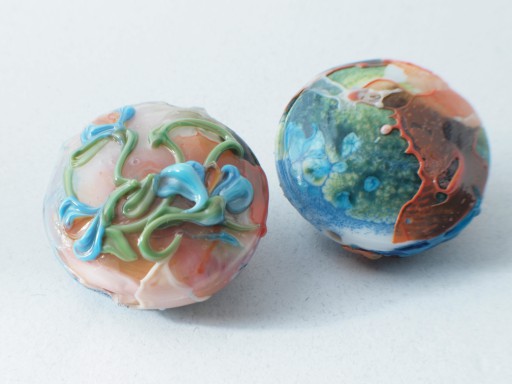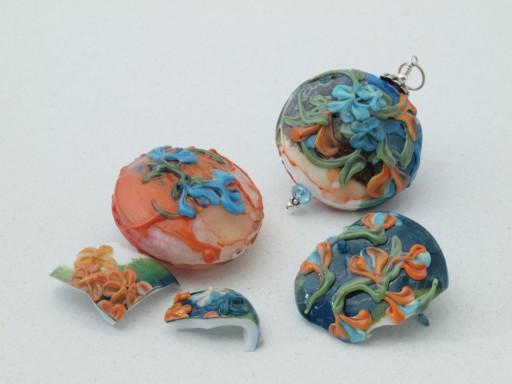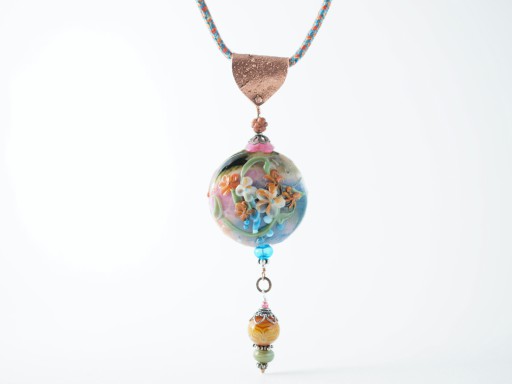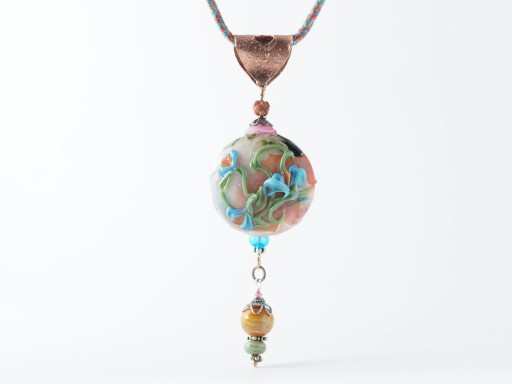Yesterday I discussed the braid I made for a necklace I intended to wear in Japan during my month long visit. Today I show the two beads I made into pendants to wear on it, along with two other beads in the series that cracked. This series has been kind of interesting for me, because so many of the beads have been failures—they've often cracked and even when they haven't a startlingly high proportion have been butt-ugly.
But I'm obsessed with them, in a somewhat lackadaisical way. I could just make abstracts, which I know how to do pretty well; ditto shards[1] ; even my florals aren't too bad. And there's no particular reason to plaster these techniques on a hollow pressed lentil.
But that's what I do.

Obverse of the two beads I chose. Sorry the one on the right is out of focus. You can see a better version further down. 1.5inch hollow pressed lentil, decorated with Effetre & CiM glass, with frit, powder (both Thompson enamel and silver green), with artist blown shards; finished with floral trailing using artist made canes.
I think there are two reasons for this: one is that these beads routinely surprise me (not least because I often choose more-or-less random floral cane); the other is that I like the layering, and though individually none of the techniques is mine, putting them together this way makes for a bead that, to my eyes at least, is recognizably mine. And having a signature design or two is generally considered sort of de riguer for a glass bead ‘artist’.[2]

Reverse of the above. I put crocus style flowers on one, and left the other ‘abstract’, without floral decorations.
I didn't make any notes on the colors I used to make the shards, but I seem to recall casing coral with CiM ginger (or vice versa)[3] .

3 1.5 lentils, two broken; made 1st and 2nd may: the orange and blue one developed a slight crack on the other side—one of the frustrations of lampworking.
Because I was in a tearing hurry, I let one of my samples cool to room temperature without annealing first, so I could get immediate feedback. Unfortunately this meant the bead cracked: hollow beads can be resistant to cracking, but the wide variety of glasses (including the semi-compatible silver green) not to mention the shape and variable wall thickness, and the relatively cold environment with hot trailing applied, meant this sample didn't survive.

Pendant, featuring textured copper bail; accented with vintage czech and artist made hollows in effetre and BE.
This more involved pendant features several mini-hollows, including a raked lotus style bead made with cosmic storm, a striking effetre odd lot with a touch of sparkle that is one of my very favorites for raked stripies, because it encapsulates so many effects in one rod. Below it, a smaller bead in a bullseye odd lot that included green goldstone, orange and white. The flower carved goldstone is an Indian bead, in a style no longer being produced.[4]

More involved pendant, reverse. Copper, silver, glass; metal fabrication, lampworking. Completed May 2014. Collection of the artist.
[1]Just because Rita Stucke isn't currently making beads doesn't mean this isn't totally her concept, of course.
[2]People can make artisan food—say bread or cheese—that, while it might be distinct, isn't necessarily identifiable as to the artist. The artist's individual stamp on things is a modern convention, and while I have no quarrel with it, neither do I believe it's essential to making good art, which is, to be sure, a minority opinion in today's world.
[3]Or something like that, anyway...
[4]Probably by very poorly paid or slave labor; the carving, though somewhat crude, is done by hand for pennies a bead.
Unless otherwise noted, text, image and objects depicted therein copyright 1996--present sylvus tarn.
Sylvus Tarn